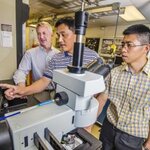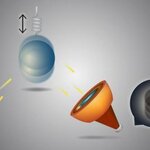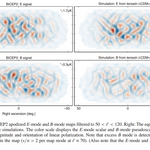Physics

Do you remember the top quark asymmetry measurements of CDF and DZERO ? A few years ago they caused quite some excitement, as both experiments were observing a departure from standard model expectations. This could really be the place where one would first observe new physics associated with top quark production, so the analyses triggered quite some theoretical investigations, deeper studies, and model building.
The quantity which was measured is a simple one to describe: by smashing together protons and antiprotons at the Tevatron 2-TeV collider, you sometimes (well, rarely in fact: once…

By trapping a magnetic field with a strength of 17.6 Tesla, roughly 100 times stronger than the field generated by a typical fridge magnet, in a high temperature gadolinium barium copper oxide (GdBaCuO) superconductor, researchers not only beat the previous record by 0.4 Tesla, they harnessed the equivalent of three tons of force inside a golf ball-sized sample of material that is normally as brittle as fine china.
The research demonstrates the potential of high-temperature superconductors for applications in a range of fields, including flywheels for energy storage, '…

You wouldn't think that mechanical force, like kicking a ball in the World Cup or embossing letters on a credit card, could process nanoparticles more subtly than the most advanced chemistry but a current paper in Nature Communications describes a now patented method to use simple pressure — a kind of high-tech embossing — to produce finer and cleaner results in forming silver nanostructures than do chemical methods.
All without harmful byproducts to dispose of.
Hongyou Fan
of Sandia National Lab calls his approach "a simple stress-based fabrication method" that, when applied to…

What is believed to be the smallest force ever measured, 42 yoctonewtons, has been detected by at the Lawrence Berkeley National Laboratory.
A yoctonewton is one septillionth of a newton and there are approximately 3 x 1023 yoctonewtons in one ounce of force.
That's tiny. Using a combination of lasers and a unique optical trapping system that provides a cloud of ultracold atoms, the researchers detected the minute force.
If you want to confirm the existence of gravitational waves, space-time ripples predicted by Albert Einstein in his theory of general relativity, or want to…

The Higgs boson was detected using its decay into bosons but scientists from the CMS experiment at the Large Hadron Collider have found evidence for the direct decay of the Higgs boson into fermions.
If the Higgs particle can decay into both bosons and fermions, we can exclude certain theories predicting that the Higgs particle does not couple to fermions. As a group of elementary particles, fermions form the matter while bosons act as force carriers between fermions.
According to the standard model of particle physics, the interaction strength between the…

The Cornell arxiv is known to not accept preprints without a minimal screening of their contents. Still, I am sometimes led to wonder if a similar attention is paid to the liberty that authors at times take with the titles of their papers.
I am officially on vacation since yesterday, so you should not expect the list below to be a very comprehensive one. I just offer four examples of titles that might have been considered for some form of moral suasion toward the author by the arxiv managers, but apparently haven't. I just quote some titles below which struck me as kind of odd.
Also, beware…

After great pains to simulate the foreground dust the Cosmic Microwave Background, gravitational wave result of BICEP2's B-Mode observations is still in question. The simple fact is we do not really know what the foreground dust contamination really is right now. The PLANCK collaboration will release that data, and sometime this year, their own map of CMB B Modes. PLANCK's release of a real foreground dust map, not one based on a presentation slide, which is what the BICEP2 team first used, will settle this once and for all. All of that said, the work of the…

After great pains to simulate the foreground dust the Cosmic Microwave Background, gravitational wave result of BICEP2's B-Mode observations is still in question. The simple fact is we do not really know what the foreground dust contamination really is right now. The PLANCK collaboration will release that data, and sometime this year, their own map of CMB B Modes. PLANCK's release of a real foreground dust map, not one based on a presentation slide, which is what the BICEP2 team first used, will settle this once and for all. All of that said, the work of the…

"Hell, if I could explain it to the average person, it wouldn't have been worth the Nobel prize.
"
R. Feynman, People magazine, 1985
I sure cannot disagree more with Dick than on the above sentence !
The muon is a remarkable particle, and its characteristics continue to be of interest eighty years after its discovery despite the fact that we have measured them better than almost anything else around. So, for instance, the muon lifetime is known to better accuracy than that of any other unstable particle; and the muon anomalous magnetic moment remains at the top of our list of things to determine more precisely nowadays.
Why do we obsess on measuring to the tenth decimal place quantities that the Standard Model predicts with extreme accuracy ? Because the Standard Model predicts them with…